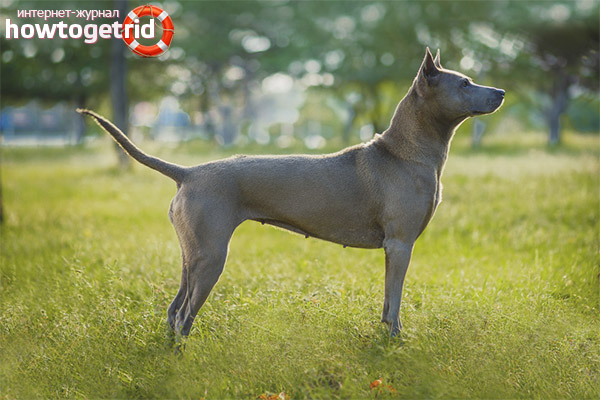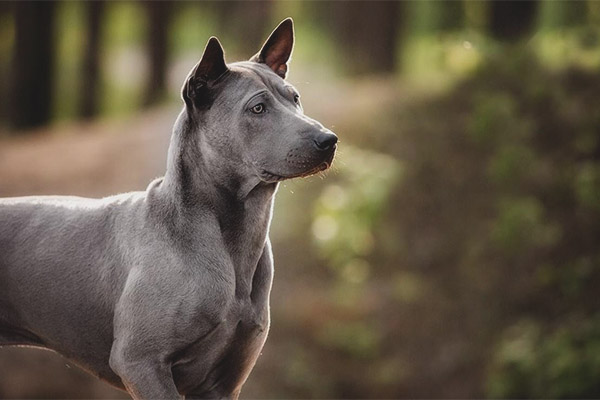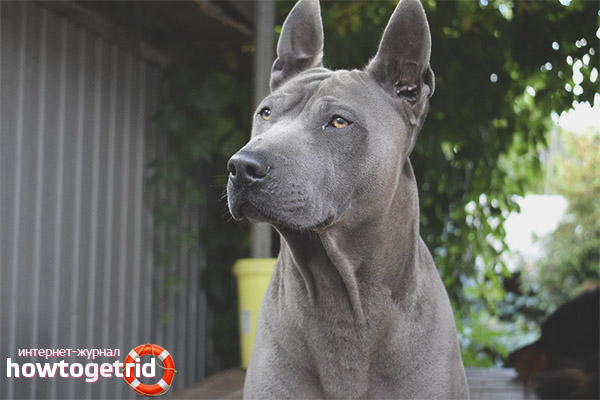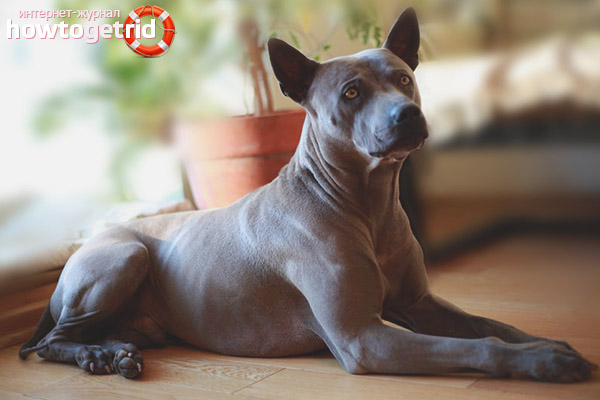The content of the article
If, suddenly, while walking around the city, you meet an extraordinary dog with a sky-blue fur color somewhere, do not start to think that your eyes have failed you. In fact, you have a unique chance to observe a rare and unique breed. Her name is Thai Ridgeback. For the first time, instances of such a dog breed reached the territory of our country only at the very end of the last century, and very soon, in 2004, for the first time, a puppy litter was obtained in a domestic kennel called “Mirage of Thailand”. Currently in Russia there are no more than four hundred representatives of this beautiful dog breed.
The history of the breed
Thai ridgebacks are among the oldest dog breeds, it is native.It is a national Thai breed, and is practically not common outside the state. A variety of studies by archaeologists provide an opportunity to assume that Ridgebacks exist on earth for about 4 thousand years. Experts found drawings of dogs with a refined sickle-shaped tail and erect ears on old rock paintings. With regards to the mentions in the letter, the first such evidence is dated to the seventeenth century.
The ancestors of these dogs were wild dingos, and the Thai Ridgeback was able to retain its original appearance for centuries, as never representatives of this breed were crossed with other species. Since Thailand has existed for a long time autonomously, in isolation from other countries, the breed has remained extremely clean, and is now considered the most distinctive and preserved original appearance.
Dog breeders of the West met this breed for the first time in the nineteenth century, visiting a colony on Phu Quoc Island. At the same time, it was already assumed that it was the fishermen from Thailand who brought these animals to the island. Cynologists doing research to establish the area where the ridgebacks came into being, found outthat Thai dogs have more ancient origins than representatives of the breed that live on the islands of Vietnam and Cambodia.
These dogs provided assistance to the shepherds, could do hard labor, guard the property. Their whole existence was filled with adversity and dangerous situations. Due to the natural selection, life was maintained only among the strongest and strongest representatives, therefore, the current Thai Ridgebacks also have good health and high endurance.
Despite such an ancient history, the breed was recognized as a separate species not so long ago on an official basis. At first, this was accomplished by the Union of Asian Dog Breeders, and after just one year — in 1990 — the Japanese Kennel Club.And, at the end, after another three years, Thai Ridgeback officially registered with the FCI. Currently, not only in Asia, but also in the States, as well as in Europe, they successfully breed Ridgebacks. But officially around the world no more than two thousand individuals are registered, which makes it possible to rightly consider the breed to be one of the most rare.
Appearance of Thai Ridgeback
The dogs are of medium size, the complexion is developed, the dog is athletic, the muscles are strong. The breed is short-haired, and the coat of coat in the direction of the back forms a specific comb. This is a strip of coat that grows in the opposite direction to the rest of the hair. Such a ridge originates in the top of the hull, and then descends in the direction of the ridge. This scallop may have a different length or shape, but symmetry with respect to the spine is necessarily preserved.
Wool can be of several different types, depending on the length of the hair:
- classical (not exceeding 2 cm, on average about 1.5 cm);
- short (from 0.5 to 1.1 cm);
- Velvet (0.4 cm);
- ultrashort (from 0.1 cm).
Also, several different colors prevail:
- reddish;
- the black;
- bluish;
- isabella.
Most often you can find dogs with a reddish color. If we consider all puppies in brood, then there are puppies with a similar coat color most often. Such a predominance can be explained by the fact that the ancestors of these dogs were tamed red dingos. Red-colored puppies have a constant pedigree, and hair crests on the back are pronounced and not very narrow.
In this case, the dominant sign is considered to be black color. If the ridgeback has the same color, then the nose, claws and skin should also be the same color, and the coat, when healthy, shines and looks glossy.
Very rarely you can meet dogs with blue color. The first representatives of the blue-haired Ridgebacks had splashes of black hair all over the coat, but with the advent of the next generations such a minus of the breed disappeared.
And as rarely as possible, finally, an isabella color is found. This combination of colors of vanilla, grapes and shades of tea rose. The tip of the noses is pigmented according to the coat, and the claws are brown.
Most often, males of this breed look more impressive and larger.If the females at the withers usually reach 56 cm, then the dogs can be as tall as 62 cm, and their weight reaches 33 kg.
Often the tip of the nose of the Thai Ridgeback is large, of a dark shade, and the eyes are real amber or have a dark brown color. The forehead and neck of these dogs are covered with folds, the ears are large, slightly leaning forward and upturned.
Such folds on the forehead and upturned ears make the dog look very serious and intelligent. The dog is highly emotional, and any excitement and experience are reflected on its face. A dog can demonstrate both strong despair and a cheerful smile.
Thai Ridgeback is very elegant, beautiful, impressive with its own exotic look and velvety, pleasant to the touch appearance. A separate unique feature is its ridge. Dogs of this breed have an athletic build, very agile, mobile and jump well. Ridgeback is taciturn, molting rarely happens and there is no unpleasant smell. Medium sized dogs are usually moderately fed.
The intelligence of these dogs is high, the ridgebacks are very attached to the owner and are constantly ready to protect the owner and the home.Their voice is very loud, soft, but barking is rarely heard, so many owners of ridgebacks admit that they have never heard the voice of a pet.
Character traits dogs
The Thai ridgeback has a very independent character, they are not intrusive, they are extremely tactful and can sometimes resemble cats with their habits. Ridgeback is very convenient for living in a city apartment, the wool does not shed them, does not emit unpleasant odors, and the dogs themselves are very neat and clean. Bitches are more gentle and understanding, and males are autonomous and can live, being left to themselves. Thai Ridgebacks do not tolerate loneliness, so the aviary is not suitable for keeping a pet in it. These dogs are very fond of all family members and can be extremely attached to them.
But Ridgeback treats strangers with suspicion and distrust, does not tolerate tenderness and touch. Males are distinguished by a certain malice and arrogance, which makes them excellent guards. Strangers can bark. They have excellent sight and sensitivity of hearing, are graceful, strong and courageous.Often a ridgeback can surprise a host by making independent and smart decisions. Badly react to rudeness. Therefore, it is hardly possible to force the Thai bridgejack to force anything.
The pet is very resourceful, inventive and smart, can quickly learn new skills, and communication with him should be built on the basis of mutual respect and unconditional trust in the owner. Ridgeback can mature to perceive different situations, and sometimes, in the process of training, begins to stubbornly and ceases to carry out those commands that he is given. Ridgeback can develop their skills from an early age, and their memory is great. Dogs of this breed are distinguished by attentiveness and observation, a very well developed skill of imitation. The dog usually turns into a great companion and companion for the owner.
Houses ridgebacks can coexist without problems with other pets, but in street conditions a dog can rush to street cats, but do not touch dogs if they do not show aggression first. Ridgeback with respect and love applies to small family members.
Representatives of this breed are active, energetic and mobile, happy to run and experience excitement if they have to participate in sports for dogs.Ridgeback is very sensitive to emotions and does not tolerate rudeness from the owner. When educating you need to be patient. These animals are freedom-loving, sometimes stubborn and arrogant, so their location can be won only by a warm and respectful attitude.
The nature of the ridgeback has feline habits, he sometimes does not take the guests very respectfully, looking at them for a long time. Along with the cat, it has a territorial form of behavior. Feels confident only being in his usual place, not wanting to leave him. Also, these dogs are not very fond of water treatments.
Standard breed indicators
Any member of this breed must externally be in accordance with the established standard. Their main purpose is to accompany the hunter or the compilation of the company to the owner. Their dimensions are medium, wool is often very short, velor, in the direction of the ridge is a comb of hair. Usually in the body of the dog exceeds the height at the withers. The musculature is well developed, the dogs are easily trained.Dogs possess considerable strength, patience and endurance, are loyal and faithful animals.
- Skull. In shape, it is rather flattened between the ears, and when viewed from the side, it is a little round. With suspicion and alertness, folds are visible on the forehead.
- The muzzle of the dog is wedge-shaped, its size is usually smaller than the top of the head.
- Lips have good tension, pigmented.
- The nose is smooth, very long, pigmented black. Only in ridgebacks with a blue color, the nose is colored accordingly.
- Jaws powerful, scissor bite. The tongue either has black patches or is completely black.
- The eyes are large, their shape is almond-shaped, the shade is brown. Sometimes, a blue ridgeback can have amber eyes.
- Ears in the shape of a triangle, not too large, turned up, slightly leaning forward.
- The neck has strong muscles, very strong, is located highly and proudly. Slightly arched, not very long.
- Torso The back is flat, strong, the croup is slightly inclined, and the loin is wide. The stomach does not sag.
- Paws are developed perfectly, oval-shaped, claws of black color.
- The coat is very short and smooth, the ridge should be clearly visible.Despite the variety of colors and shapes, the ridge needs to be symmetrical.
Even minimal discrepancies with the standard can be a disadvantage, and its assessment is made on the basis of how strongly the deficiency is expressed. A vice for disqualification is the lack of a ridge, too long coat or excessively evil behavior.
Thai Ridgeback Care

It is convenient to keep Thais in an apartment due to the absence of smells, saliva and very infrequent shedding. And the wool is easily removed with a conventional vacuum cleaner. Ridgeback is very mobile and energetic, especially true for puppies. But to increase the level of stress on the puppy should be planned and slowly. Otherwise, the bones and joints of the dog will develop incorrectly. With a puppy you need to spend a lot of time, educate him, socialize and train. With an adult, you can easily go for a long walk or bike ride.
Ridgeback is too clean, it does not run through puddles and bypasses areas with mud and slush. After walking it will be enough to wipe the pet's paws.The water procedure should be subjected rarely, no more than 3-4 times a year. For combing wool, it is desirable to use a special mitten of rubber.
Young ridgebacks need constant activity and long walks - up to a couple of hours daily. Already an adult dog will be content with a couple of half-hour walks a day. But at the first opportunity it is better to go with the dog to the country or give it a chance to walk longer. During the walk, the ridgeback behaves calmly, does not pull down the leash and does not break into a sharp run.
Raising puppies
Ridgebacks love freedom and show their character at the first opportunity, so you need to be prepared for the constant struggle with the pet's persistence and the search for a common language. You must immediately make it clear to the puppy who in the apartment is the real owner. Also, a Thai man must understand that he is forbidden to perform certain actions without the permission of the owner.
The process of education should be different sequence, regularity and perseverance. This is the only way to overcome the stubbornness that nature has inherent in the ridgeback.
Cost of
This is an extremely rare breed, which makes it extremely expensive for its representatives. Sometimes the breeder is required to travel for a dog to Europe, to spend money on medical tests and pay, in fact, for the very mating. Usually the cost per puppy of a Thai ridgeback is at least 1,700 euros, and may end up in the region of two tens of thousands of euros.
Video: Thai ridgeback dog breed













To send